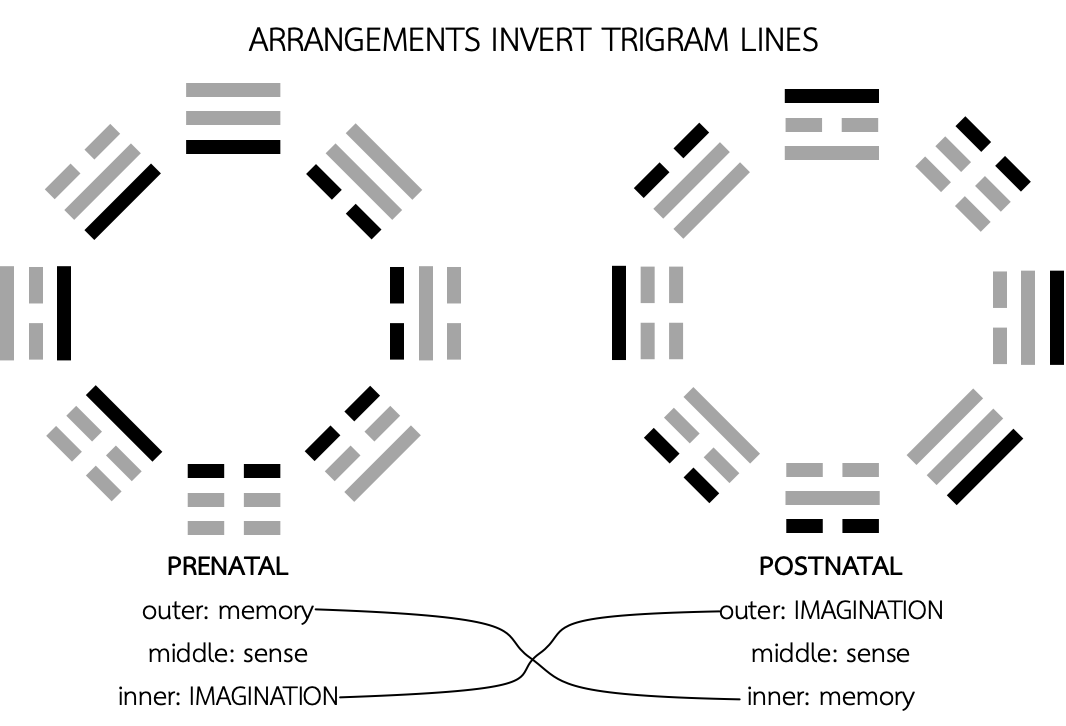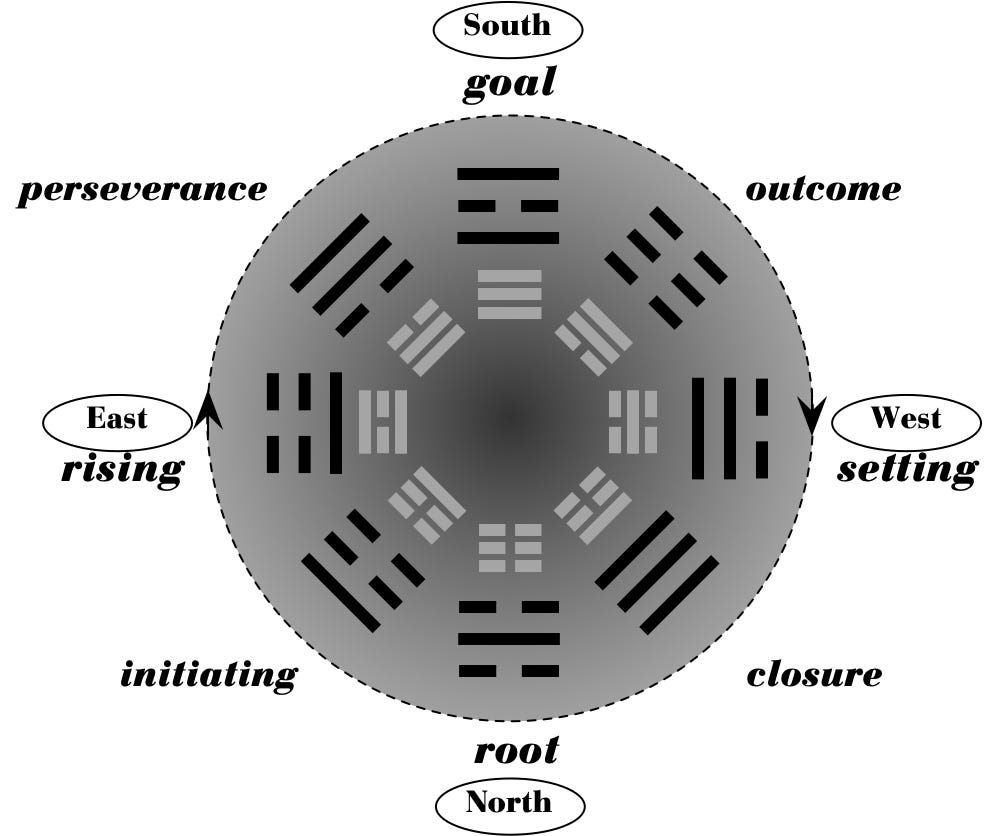Trigram Theory & Bagua
Introduction to the Prenatal and Postnatal Bagua Arrangements
This article assumes a solid understanding of the proposed trigram theory as described in Part 1 (if you are not familiar with the theory described in Part 1 this article may be difficult to understand).
Note: Few people have difficulty with the term “material” but some rationalists may balk at the term “spiritual”. It would be evasive to use a term other than “spirit” in this work as the concept is deeply embedded within the tradition under consideration. Nevertheless, for the sake of those who might otherwise be willing to read this work — please try substituting “observer” for “spirit” and “phenomena” for “material”. The observer denotes the realm of the "experiencer" — the one having the experience. The observed denotes the realm of whatever is experienced — the phenomena.
It’s the interaction of the observer with phenomena that is the basis for this system of thought.
A Brief Recapitulation of the Trigram Theory under consideration
Each trigram is taken as representing a particular “state of mind”. The solid yang line
represents the attention of the mind and the broken yin line an absence thereof.
The yang lines of each trigram indicate the attention of the mind within three domains of cønsciousness:
SENSE is the Observer experiencing Phenomena (middle line).
The Mind stores through the faculty of MEMORY (top line).
The Mind processes sense and memory via IMAGINATION (bottom line).
The basis for this theory is its correspondence with the poetic terms traditionally associated with each of the 8 trigrams (as described in Part 1).
In this article the proposition is made that the poetic language of the trigrams in the Prenatal describe spiritual cønsciousness while in the Postnatal they describe materially-bound cønsciousness.
Taken together the bagua arrangements can be seen as constituting a complete model of experiential reality.
“Prenatal” vs. “Postnatal”
Consider the meaning of these terms. Postnatal means “after being born”, Prenatal means “before being born”. Postnatal thus refers to the ordinary mind states of all things born into this world. Prenatal suggests mind states prior to physical existence.
This corresponds with a common theme in Taoist texts – to return to an original pure state of being “like a newborn before it learns to smile” [Tao Te Ching].
Reversal of Mental Attention in Yang Lines
The concepts of “reversal” and “inversion” are of key importance in Taoist thinking.
“THE ORDINARY COURSE IS IN DAILY ACTION; THE TRUE SOURCE REVERSES THIS, BUT WHO IS THERE WHO KNOWS? I INFORM THOSE OF YOU WHO STUDY THE TAO; IF YOU DO NOT KNOW YIN AND YANG, DO NOT ACT RANDOM.”
“IF YOU DO NOT KNOW INVERSION WITHIN THE MYSTERY, HOW CAN YOU PLANT A LOTUS IN FIRE?”
Excerpts from Chang Po Tuan's “Understanding Reality” (translated by Thomas Cleary)
Yang (solid “firm” line) indicates the attentive focus of the mind and Yin (broken “yielding” line) indicates a lack thereof. It's essential to realize that the the focus of the mind may be used in two profoundly different ways:
1) In ordinary life the attention of the mind is used to cultivate mental objects. We pay attention to our Senses, our Memories and our Imagination under the reasonable (yet dubious) assumption they are significant and useful.
2) The mind can be used extraordinarily to restrain mental objects. Many of the world's great spiritual traditions emphasize that the correct use of the mind is to calm mind activity.
In the Prenatal the effort of the mind MAY be reversed from its ordinary Postnatal course:
Note that the Prenatal can also be fruitfully interpreted with Yang focusing attention on mind objects. However, this takes place solely within the root context of ☷ (Receptive Earth), signifying that all Prenatal mental objects are received in emptiness, not generated by sense desires.
Trigram Inversion
The Postnatal arrangement as shown in this document features the trigrams upside-down to the Prenatal. In the Prenatal the bottom line (IMAGINATION) is on the inside of the arrangement, in the Postnatal it is on the outside of the arrangement.
Surveying the many Postnatal arrangement images this inverted orientation is relatively common (even on old examples of the arrangement). However, there are also many examples of the Postnatal trigrams depicted in the same orientation as the Prenatal. Nevertheless, it is reasonable to think the inverted version contains symbolic significance given the Taoist thematic concepts of reversal and inversion.
If you didn't know the trigrams were inverted it would appear that two of them are in the same position within both Prenatal and Postnatal arrangements.
Postnatal Dissipates, Prenatal Converges
MEMORY represents what we've already been through. IMAGINATION represents potential: what we're heading towards in the future.
Prenatal's IMAGINATION (bottom line) on the inside of the arrangement suggests that evolutionary potential lies within the center of spiritual being.
Postnatal's IMAGINATION on the outside suggests an outwardly directed gaze where one is under the impression that life's potential is somewhere “out there” in the world of material phenomena.
Imaginative potential becomes our influence on the future towards which we are continually heading. With the IMAGINATION line on the inside the Prenatal suggests a convergence towards the center whereas the Postnatal suggests a dispersion away from the center.
Mental Patterns
The Bagua arrangements describe two elemental patterns of mental activity.
The Postnatal describes the patterns of a mind absorbed in the world of material phenomena.
The Prenatal describes the patterns of a mind absorbed within spiritual being.
States of mind manifest their qualities and significance in relation to each other. Whether there are only two fundamental arrangements to states of mind is open to debate but it's interesting to note that the field of psychology has some proponents of this view. For instance, Sigmund Freud posited that there were “two principals of mental functioning” which he identified as the “pleasure principal” and the “reality principal”.
Another model of perception is Daniel Kahneman's “system 1 & 2”. System 1 is described as effortless, immediate and associative. System 2 is effortful, time based and disassociative.
These bifurcated models of mind and psyche correspond quite beautifully with the two bagua arrangments. This basic split in functionality also applies to the substrate of the autonomic nervous system. The sympathetic “fight or flight” mode can be correlated with Postnatal's Sense engagement with the world of phenomena, the root state of mind being ☵ (engaged with sense). The parasympathetic “rest and digest” mode requires the absence of any immediate material concern where the root state of mind is empty of mind objects (☷ Receptive Earth).
Compass Directions & Cyclicality
Both Bagua arrangements are traditionally set to the points of a compass suggesting a cyclical clockwise movement from one trigram to the next.
Maps in ancient China were drawn with South at the top of the page. This places East to the left, West to the right and North at the bottom.
Following the natural cycle of day and night: East is associated with rising and West with setting. South is the apex (the flowering, the goal) and North is the nadir (the root, the wellspring/source).
The daily rising and setting of the sun and consequent distinction between day and night provide the ideal metaphor for cyclical thought patterns. Every pattern of thought reaches towards its goal (South / Brightness) and returns back to its ground state (North / Darkness). Thought patterns have distinct characteristics on the way up (East) and a different set on the way down (West).
The top Southern trigram signifies the goal towards which the mind orients itself.
The bottom Northern trigram signifies the ground state basis for the pattern.
A comparison of the trigrams occupying the south and north highlights the profound differences between the two bagua.
In the Postnatal
The Southern position is Fire ☲, signifying that individual desires & aversions are the mind's primary goal.
The Northern root position is Water ☵, which suggests that desires & aversions are rooted in sensory experience.
In the Prenatal
The Southern position is Heaven ☰, signifying that the way of the cosmos is the mind's aspiration.
The Northern root is Earth ☷ which suggests that the gateway to transcendent being is cultivated by a neutralized & receptive mind.
We can now see how Freud's “Two Principals of Mental Functioning” aligns with the bagua. His “pleasure principal” corresponds with the Postnatal arrangement: rooted in Sense Experiences the primary goal is to seek pleasure and avoid suffering. Were it not for our engagement with our senses (☵) we wouldn't have the experiences that cause us to develop our desires & aversions (☲).
Freud's “reality principal” correlates with the Prenatal arrangement. Any rigorous and honest analysis of life's circumstance leads inexorably to the conclusion that absolute reality cannot be grasped by the analytical mind. Thus the ancient traditions advised “abiding within nothingness”(☷). ☷ is the root – the key to understanding reality. Reality means accepting our humble position, embracing not-knowing and allowing the Cosmos (Heaven/Tao) to take its course. Mind objects are seen as “clouds in the sky”, obscuring the pure energy of Heaven and obstructing concordance with the Tao.. Even the most dedicated and wise follow the Tao only to the best of their ability sometimes employing non-action and sometimes acting. But who can say if it's being done correctly? This is why the true path is considered “the most subtle of the subtle”.
“No one can control the gate of calamity or fortune - but the sage does nothing to bring about calamity and nothing to repel fortune.”
Many spiritual practices are centered on mind-clarifying techniques (☷) to free the individual self from its “temporal conditioning” (habits of mind). Successful practice is said to open one to the eternal domain of absolute reality (☰). Reality consists of cønsciousness in relation to cosmos. Although we are fundamentally unable to grasp all this signifies we can approach absolute reality through the recognition of our ignorance and the embrace of the eternal mystery.
Spiritual traditions often describe the ground of being as nothingness (this being the case within both Taoism and Buddhism, the schools of thought most closely associated with these symbols). Thus we can rightly see ☷ as the basis for reality.
This same principal can be framed in scientific terms: IF there was a beginning to the universe (“big bang”), there was no material phenomena prior. Therefore the entire cosmos came from nothing. ☷ is therefore the state from which the entire universe was born (PRE-natal).
Neutralization of Mind-Objects
Each trigram within the Prenatal is positioned across from its opposite (solid lines become broken & vice-versa). This corresponds to a mental sublimation technique wherein mind states are neutralized by their opposites.
This technique of mind-object neutralization through opposition or “reversal” is described variously within Taoist and Buddhist traditions but perhaps most eloquently and explicitly in the Yoga Sutras of Patanjali.
“When improper thoughts disturb the mind, there should be constant pondering over the opposites.”
“...any thought originating in desire, anger or delusion, whether mild medium or intense- do all result in endless pain and misery. Overcome such distractions by pondering on the opposites.”
Patanjali 2.33 & 2.44
Earth ☷ at the bottom in the North is the ground state – the root of the mental framework. The Prenatal is built from this primordially receptive emptiness. No matter where you are in the Prenatal arrangement, ☷ is the lens through which things are seen.
Contrast this with the Postnatal where ☵ is the root. Everything on the wheel of samsara is built from the attachment to sensory experience. With the exception of ☵ and ☲, no trigram is balanced by its opposite in the Postnatal. Sense ☵ and Desire/Aversion ☲ are the primary pole around which life energies dissipate. This is the perspective that comes from attachment to physical life and its inexorable thermodynamic decay.
Within Prenatal's absolute reality (Tao) evolution proceeds naturally on the basis of Heaven's creative potential (☰) arising from Earth's receptive acceptance (☷) as “myriad things” come and go.
The next article in this series will detail the cyclical mental patterns for each bagua arrangement.
Videos on this subject can be viewed on the TAIJIREALITY YouTube channel
To support these efforts:
Correspondence: taijireality@protonmail.com
PODCAST: Assembly of Silence Radio Hour
FOOTNOTES
Some variations do exist but the two arrangements shown here are by far the most common.
The Chinese saying “the Emperor always faces South” suggests a possible reason for this map orientation, perhaps because (from the Northern hemisphere) we face South towards the sun.
Whether or not the movements in the arrangements are restricted to only this clockwise cyclical pattern is an interesting issue that I've discussed occasionally on my YouTube channel. An example:
The ancient Greek word “Cosmos” means “order” and is perhaps somewhat analogous to the concept of “Dao” or “Way”: the transcendent and ineffable absolute reality (often associated with divinity).
Keep in mind that “Earth” (☷) is a poetic term not about this the planet or its soil but rather a state of mind. It is tempting to slip back into thinking of the ordinary meaning of the names of the trigrams. However, from the point of view of this model the common referents of these terms are not what's being discussed. They are poetic metaphors. For this reason I minimize the use of the names in this document and when possible use the trigram symbol instead.
“Myriad things” is a phrase often used to translate a Taoist concept 萬物 (wanwu) signifying all the various existing entities in the empirical world.












